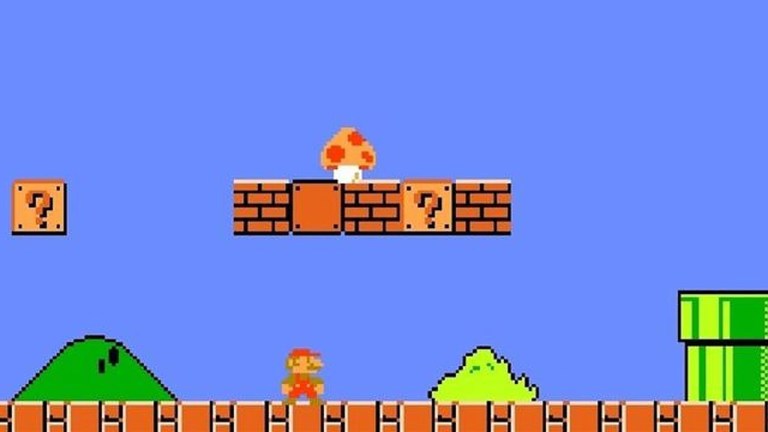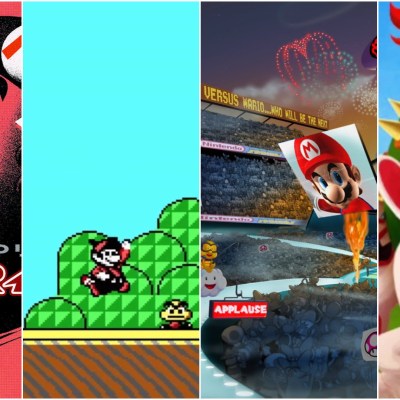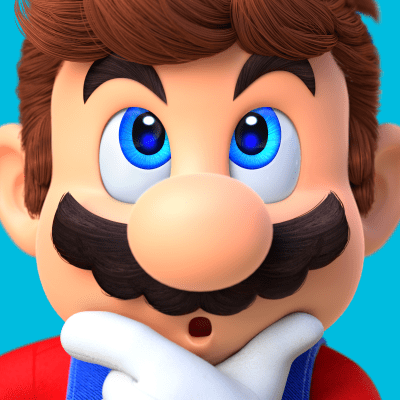How Super Mario’s Most Iconic Power-Up Was Inspired by Magic Mushrooms
The idea that the mushrooms in Super Mario games were actually inspired by drugs isn't as ridiculous as you might think.

I don’t remember the first time I heard someone joke about Mario getting high in Super Mario Bros. by eating all the mushrooms he finds, but it certainly feels like that joke is old as Super Mario Bros. itself.
If you hear that joke when you’re 12 or 22, you’ll likely treat it like some kind of incredible revelation that changes the way you look at the Super Mario Bros. franchise. At some point, though, the gag becomes yet another example of someone trying to apply an edge to a kid-friendly product by making some kind of barely believable suggestion that the whole thing is actually about something slightly darker. It’s a funny thing to joke about, but it starts to get a little more awkward when someone treats that theory as the absolute truth.
Do you know what’s really funny, though? It turns out that the old joke about Mario getting high on mushrooms may not be quite as ridiculous as you might think it is. Actually, the origins of Super Mario’s mushrooms are as confusing and enlightening as the average trip on so-called “magic mushrooms.”
Shigeru Miyamoto’s Confusing Statements About the Origins of Super Mario’s Mushrooms
While you’d probably assume that the best person to ask about Super Mario‘s mushroom mystery is Super Mario Bros. creator Shigeru Miyamoto, the strange fact of the matter is that Miyamoto’s official statements on that subject are a big part of the reason why this whole magic mushroom debate is as confusing as it is.
In a 2005 interview with Business Week (which has sadly since been scrubbed from the internet), Miyamoto offered this seemingly simple explanation for the origins of Super Mario Bros. mushroom power-up:
“‘Mario ended up being too big, so we shrank him. Then we thought, ‘What if he can grow and shrink? How would he do that? It would have to be a magic mushroom! Where would a mushroom grow? In a forest.’ We thought of giving Mario a girlfriend, and then we started talking about Alice in Wonderland.’”
Again, that seems like a pretty straightforward explanation for the whole concept. Alice ate a mushroom in that story that made her larger (or, to be more specific, one side of the mushroom made her “grow taller” and the other made her “grow shorter”) and so did Mario. Just as we’ve all accepted that the visual of Link pulling the Master Sword from a stone was clearly borrowed from the classic English fantasy story The Sword in the Stone, it really shouldn’t be that hard to accept that the idea of Mario growing larger from eating mushrooms was inspired by Alice in Wonderland.
Yet, it seems like Miyamoto himself has had trouble simply accepting that seemingly obvious reference. In fact, in a 2009 interview with the late Satoru Iwata, Miyamoto suggested that his Alice in Wonderland quote may have been misinterpreted.
“Some time ago I was being interviewed and I spoke about Alice in Wonderland,” Miyamoto said. “But it seems there was some misunderstanding and it’s since been stated that I was influenced by Alice in Wonderland. That isn’t the case. It’s just that there has always somehow been a relationship between mushrooms and magical realms. That’s why I decided that Mario would need a mushroom to become Super Mario.”
Miyamoto seems to be suggesting that people took his quote to mean that Mario’s mushrooms were directly borrowed from Alice in Wonderland when he actually meant that he was actually inspired by fantastical stories like Alice in Wonderland which used mushrooms as a kind of gateway between our world and those magical realms.
It’s easy enough to buy into the idea that Miyamoto’s quote may have been mistranslated or simply misinterpreted by those who read it, but it still feels odd that he felt the need to go out of his way to address the Alice in Wonderland comparison. After all, it just seems so obvious that the idea of Mario eating a mushroom to grow larger would be borrowed from a story that made that very specific idea famous. Why would Miyamoto seem so determined to walk back that idea?
The answer may have something to do with Alice and Wonderland‘s relationship with psychedelic drugs.
Alice in Wonderland, Drugs, Mushrooms, Fantasy Stories, and Super Mario’s Other Influences
Look, I’m not going to blow anyone’s mind by saying that Alice in Wonderland is now commonly associated with drug use. The idea that the entire story is some kind of hallucinogenic voyage gained momentum in the 1960s, and it’s really only become more popular since then. Jefferson Airplane wrote a song about it, the entire Matrix franchise is based on that idea (in its own way), and everyone from your stoner roommate in college to esteemed literary professors has offered some kind of interpretation of Alice in Wonderland that suggests the whole thing is either about drugs, was written under the influence of drugs, or can be interpreted in a way that makes it easy to see it as an allegory for drugs. It’s not unreasonable to suggest that a lot of people’s minds probably jump to drugs when they hear “Alice in Wonderland.”
However, the fact of the matter is that there’s very little evidence that suggests Alice in Wonderland author Lewis Carroll intended for it to be a story that was “secretly” about drugs or even that he was under the influence of any notable drugs when he wrote the story. In fact, most of the hallucinogenic drugs that Alice in Wonderland is commonly associated with these days (LSD, mushrooms, acid, etc.) either wouldn’t have been available or weren’t recreationally popular at the time that Alice in Wonderland was written. Carrol was known to drink wine from time to time and theoretically could have used some amount of opium during his life (it was a pretty common drug at the time), but there’s certainly nothing to suggest he was experimenting with the kind of hallucinogens that Alice in Wonderland is often associated with or was even especially interested in the subject above other, more prevalent themes in the novel.
As Miyamoto noted in that 2009 interview, mushrooms have also historically been associated with other fantasy realms. The relationship between mushrooms and magic really gained steam in the early 1800s when fantasy writers like the Brothers Grimm became fascinated with the rate at which people were moving out of the country and into cities. Some at the time feared that the migration from the countryside to cities would not only mean that more rural areas would be swallowed by urban expansion but that the folklore, history, and culture of the country would also be lost in the process.
As such, more and more fantasy stories used aspects of nature (such as mushrooms) as a kind of shorthand symbol for the idea of these magical settings where mysticism was still alive. The close relationship between nature and magic wasn’t invented during that time (Shakespeare and others had played with that concept well before then), but that era certainly saw a rise in mushrooms being used to symbolize fantasy lands.
All of that information supports the theory that Miyamoto and the Super Mario Bros. team saw mushrooms as a fantasy gateway device, but none of it outright dismisses the popular association between Mario’s mushrooms and drugs. After all, the “Alice in Wonderland is about drugs” theory was firmly established by the time that Super Mario Bros. was released in 1985. By that point, you could argue that the idea of mushrooms in a fantasy environment were as closely associated with drug use as they were with rural folklore. Wouldn’t the Super Mario team have been fully aware of that association at the time they were working on the game?
To answer that question, you first have to understand a little more about the real-life history of “magic mushrooms.”
The Real World Origins of Super Mario’s Magical Mushrooms
The classic “red cap with white spots” mushroom you see in the Super Mario Bros. games is based on the Amanita muscaria mushroom (also known as the fly agaric or fly amanita mushroom). It’s the same mushroom that many fantasy illustrators and writers have used in their own works throughout the years, which actually makes a lot of sense. Not only is the mushroom commonly found in parts of northern Europe where many of those classic fantasy stories were written, but there’s something striking and otherworldly about the look of the mushroom itself.
Indeed, the striking look of that particular mushroom may have only offered an additional incentive for Miyamoto and the Super Mario Bros. team to choose it as the visual basis for their in-game power-up. After all, Miyamoto previously talked about the challenges of convincing players that the mushroom was a beneficial item and not another enemy like the mushroom-shaped Goombas. One of the best ways to show players that the mysterious item was a “good mushroom” was to make it more colorful than those early enemies.
What’s especially interesting about the idea of that mushroom being a beneficial mushroom is that the real-life Amanita muscaria mushroom is actually incredibly poisonous. While it’s not necessarily deadly (though it certainly could be if you eat too many of them), some of those who have eaten smaller quantities of that mushroom have described experiencing feelings of nausea and even experiencing seizures. However, others have said that eating that mushroom caused them to experience one of the most powerful and profound hallucinogenic experiences in their lives.
While the Amanita muscaria mushroom isn’t really the mushroom you think of when you think of people using “hallucinogenic” mushrooms both recreationally and in the treatment of depression, PTSD, and other mental disorders, it can cause you to hallucinate. In fact, some of those who have experienced the mushroom’s hallucinogenic effects have described it as a kind of “psychedelic ketamine.” While researchers are still experimenting with the potential benefits of using that mushroom’s chemical properties, it’s not currently considered to be one of the most popular mushrooms for either recreation or medicinal purposes.
That also means that it’s highly unlikely that the Super Mario Bros. team directly associated that particular mushroom with psychedelics at the time they settled on that power-up’s visual design. However, that doesn’t mean that the team wouldn’t have been aware of the concept of “magic mushrooms.”
In fact, the term “magic mushrooms” was publicly coined in 1957 when Life magazine ran an article called “Seeking the Magic Mushroom.” The article followed the journey of mycologist R. Gordon Wasson who is believed to be one of the first Western researchers allowed to experience a special shaman ceremony involving hallucinogenic mushrooms. While that obviously wasn’t the first time that anyone has used mushrooms for that purpose, the publication of that article made many more people aware of the concept of psilocybin mushrooms and their effects/potential benefits. From there, the term “magic mushrooms” became a pretty popular way to describe the emerging culture of psilocybin mushrooms.
Why is the popularity of the term “magic mushrooms” and its association with drugs so important to this conversation? Well, it’s because Mario’s mushroom power-up was described as being a magic mushroom in the original version of the Super Mario Bros. instruction manual.

That information brings us hurtling back to the idea that the Super Mario Bros. team was not only aware of the association between mushrooms and hallucinogens but directly inserted a reference to those drugs in the game’s instruction manual. However, this situation may not be quite as simple as all that.
Were Super Mario Bros.’ Mushrooms Really Inspired by Hallucinogens?
This is the point of this conversation when we have to steer away from the facts of the matter and veer towards speculation. After all, while some associated with Super Mario Bros.’ development have addressed the magic mushroom theory in their own ways over the years, we still don’t really have a definitive idea of what was going through everyone’s heads at the time of the game’s development.
“Everyone” is the keyword there. I truly believe that Shigeru Miyamoto believed that Super Mario’s magic mushrooms were based more on the mushrooms seen in various fantasy stories over the years and less on the culture of psilocybin mushrooms. Several early Nintendo works are based on popular fiction in Western culture, we know that Miyamoto is often inspired by nature, and it’s not ridiculous to suggest that someone from Miyamoto’s generation and cultural background may have been just as likely (if not more likely) to think of classic fantasy works when they see mushrooms as they would be to think about drugs. I don’t imagine Miyamoto high-fiving the development team as they all celebrated slipping some drugs past the censors.
At the same time, it seems highly unlikely that Miyamoto (and others involved with the game’s development) weren’t at least aware of the meaning of the phrase “magic mushrooms” and the conclusions people were going to reach when they saw mushrooms in that game. I’m willing to accept that the association didn’t bother them enough to drop the idea entirely, but it would be wild to learn that everyone involved in the game’s development, promotion, and packaging was completely in the dark regarding the meaning of that phrase and its relationship with strange voyages both fictional and otherwise.
The one thing I’ve never been able to wrap my head around is the idea that Miyamoto wanted to play down the direct association between Alice in Wonderland and Super Mario Bros. I suppose it’s possible he was trying to do a little PR work after a slip of the tongue, but it seems like he would have jumped at the opportunity to issue a retraction or correction sooner than he did if that was the case. Did he want to give full credit to the various fantasy works that inspired the whole “mushroom concept?” Was he misquoted (or perhaps simply misspoke) and didn’t want people thinking that there was a straight line between Alice in Wonderland and Super Mario that didn’t really exist? Is it possible that Miyamoto saw the Alice in Wonderland line fuel the “drug theory” and decided to throw a little cold water on that idea?
Whatever the case may be, the one thing I’m sure of is that this whole conversation is more complicated and fascinating than it sometimes gets credit for.
It’s highly unlikely that Super Mario Bros. was designed to make people believe that the entire game was the result of some hallucinogenic trip or even that Mario was actually doing drugs. I’ve heard it said that the theory that Alice in Wonderland is actually about drugs says more about the people who believe in it than it does about the validity of the theory itself, and I think that there’s something similar at play here. That interpretation of Mario’s magic mushrooms isn’t completely outlandish, but it does start to fall apart when you argue that the whole game is “secretly” about drugs.
Still, those interpretations are examples of how culture changes over time. If there ever was a time when people didn’t immediately assume that seeing a character eat mushrooms in a fantasy land was some kind of coded commentary about drugs, that time isn’t now. The idea of mushrooms representing a voyage to somewhere fantastical has splintered into these separate concepts that often run parallel to each other and even intersect in fascinating ways. The whole idea of Mario getting high may never have never been anything more than a playground joke, but the association between Mario’s mushrooms and magic mushrooms is real enough to ensure that you don’t need to open the doors of perception simply to see it.


